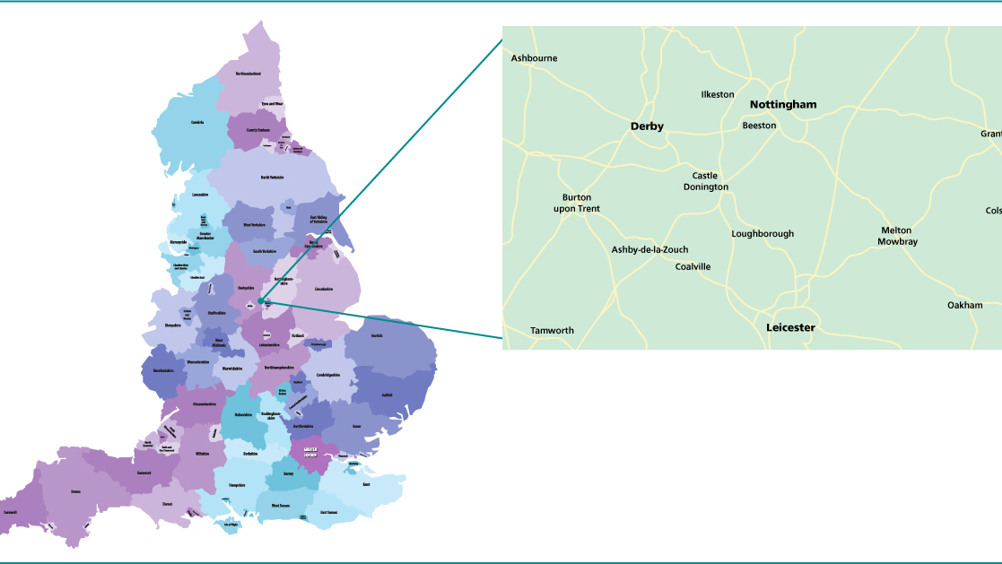The roundworm species Toxocara canis and Toxocara cati are responsible for the largely neglected parasitic disease toxocariasis (Woodhall et al, 2014). In England, estimates suggest that up to 14.3% of children between 3 and 7 years of age are infected (Josephs et al, 1981). Serological analysis has shown Toxocara spp. to be far more prevalent in less socioeconomically advanced countries (Chen et al, 2018), reflecting risk factors experienced by poorer nations, such as inadequate sanitation, education and hygiene (McGuinness and Leder, 2014). Nonetheless, there is a prevalence of 5.1% in Americans over 6 years of age, indicating the global significance of this parasite even in developed countries (Liu et al, 2018). Moreover, a study has found that children infected with Toxocara spp. have potentially reduced cognitive function (Walsh and Haseeb, 2012). Humans, alongside small mammals (Chen et al, 2018) and earthworms (Mizgajska, 2001), are paratenic hosts for Toxocara spp., within which the larvae cannot complete their life cycles but can still cause a considerable pathological damage. The nematodes T. canis and T. cati do however have definitive hosts in which they can complete their lifecycles, namely dogs and cats, respectively. A Swiss study has also identified foxes as a potential definitive host of T. canis (Reperant et al, 2007).
It is estimated that there are at least 100 million dogs infected with T. canis globally, with a prevalence of 10.8% in Europe and 4.4% in the UK (Rostami et al, 2020). T. cati prevalence is highly important given that infection with T. cati corresponds to doubling the risk of Toxoplasma gondii infection (Jones et al, 2008). Research has been conducted into seroprevalence in UK adults, with values ranging between 2.1% and 2.6% having been recorded (de Savigny et al, 1979). Far higher rates are found in children; studies in the US and UK recorded a prevalence of 13.4% (Walsh and Haseeb, 2012) and 14.3% (Josephs et al, 1981) respectively. Limited data are available on the current level of human infection in the UK, as toxocariasis is a non-notifiable disease (Buckoke, 2020). However, data exist highlighting the changing pet population in the UK; since the beginning of the COVID-19 pandemic 3.2 million households have acquired a pet (Pet Food Manufactcurers' Association (PFMA), 2021). This may impact seroprevalence in the UK as previous studies have established a correlation between pet ownership and exposure to Toxocara spp. A study conducted in Sao Paulo, Brazil found an 8.86% serum antibody prevalence in women living in households with dogs compared with 2.93% in those women who did not. Curiously, a similar trend was not observed in males (Chieffi et al, 1988), however, a separate study from Northeast Brazil found that 54% of children with anti-Toxocara spp. IgG had dogs at home (Mendonça et al, 2013), highlighting the increased risk associated with dog ownership.
A study in Lancashire utilising faecal analysis discovered 5.3% of dogs were infected with T. canis and 26% of cats with T. cati (Wright et al, 2016). Comparing such findings with the estimated UK dog population of 9.6 million and cat population of 10.7 million (PDSA, 2021) is insightful when quantifying nationwide levels of toxocariasis. The last Toxocara spp. soil contamination study in England was conducted in 2006. It revealed an overall Toxocara spp. soil prevalence of 30% in non-enclosed play areas, 17.8% in enclosed play areas and 18% in open parkland, with 63% of the sites indicating contamination (Kirchheimer and Jacobs, 2008).
Toxocara eggs that are deposited into the environment through fouling of dogs, foxes, and cats represent a major source of infection to humans (Morgan et al, 2013). This is partly because of the longevity of the eggs, with the tough outer shell permitting survival for years in soil (Keegan and Holland, 2013). Given the significant role of soil contamination in the epidemiology of Toxocara spp., the objective of this study was to determine the level of soil contamination of public parks in the East Midlands region with Toxocara spp. eggs; the hypothesis was that soil samples in public parks within the East-Midlands region are contaminated with Toxocara spp. eggs. Investigating the degree of soil contamination with Toxocara spp. eggs can provide an indicator of the potential health risks posed to children and reveal whether adequate measures are in place to prevent contamination.
Methodology
Study area
The study was conducted in the East Midlands region of England which contains three major cities, Nottingham, Derby, and Leicester (Figure 1). The city of Nottingham is 75 km2 (Britannica, 2020), Derby 78 km2 (Britannica, 2015) and Leicester 73 km2 (Britannica, 2022). The East Midlands has an average temperature of 10°C and a precipitation level of 26.5 mm per month (Anon, 2018a).
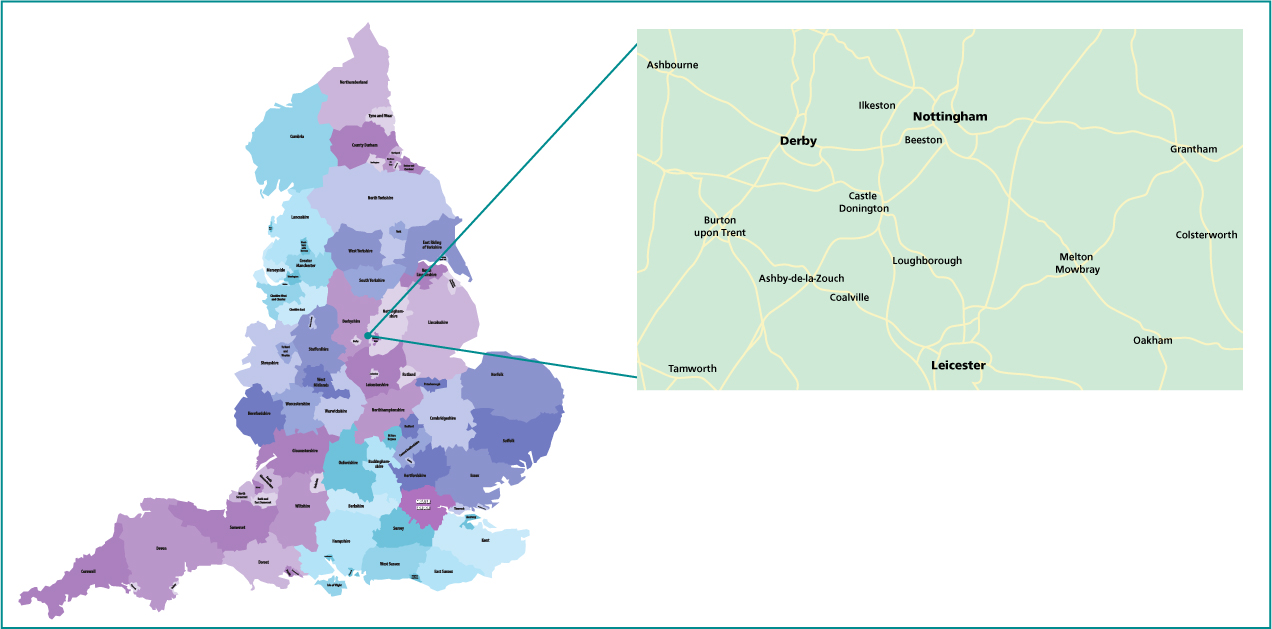
Geographical location of the sampling sites
Sampling sites were randomly selected from each city, including Derby (Figure 2), Leicester (Figure 3), and Nottingham (Figure 4), with a total of 405 soil samples collected from 23 parks across the East Midlands region. The number of samples collected from each site was based on the surface area of the play area and park. At the time of collection, the soil samples were visually graded as either moist or dry. Each pinpoint on the map corresponds to one park site in the study area.
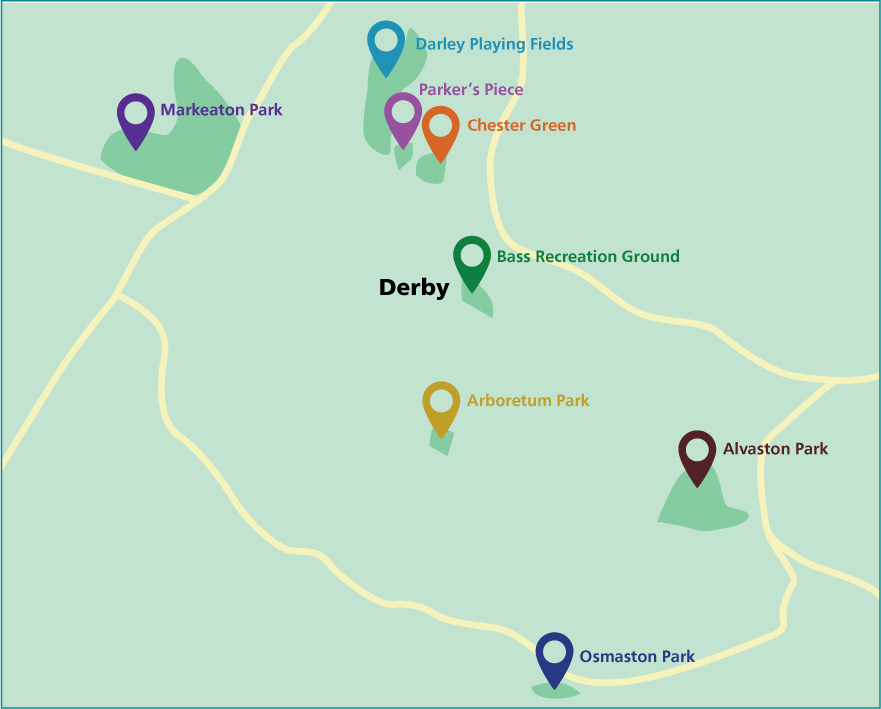


Soil sampling
The surface soil was used as the study object and was sampled between March and May 2018. Each soil sample gathered weighed 50 g and was collected from five places within a 1 m2 area. Samples were taken from the top 5 cm layer, placed into a labelled container and tested in the laboratory.
Recovery of Toxocara spp. eggs from soil samples
Toxocara spp. eggs were isolated from the soil samples using a previously established method (Dunsmore et al, 1984) with some modifications (Mandarino-Pereira et al, 2010). Because molecular analysis was not performed and owing to the morphological similarities between the eggs of T. canis and T. cati (i.e. roughly spherical, with a thick and regularly pitted shell), the detected eggs were reported as Toxocara spp.
Statistical analysis
All statistical analysis was performed using the XLMiner Analysis ToolPak version 2.0.0.0 add-on as it allows comprehensive statistical analysis. Parks and their respective play areas were compared using a paired t-test. Moist and dry samples were examined using a two-sample t-test assuming equal variance as the groups were independent of one another. P values of <0.05 were considered statistically significant. Spearman's correlation calculation was used to quantify the relationship between park prevalence and surrounding human population density. Pearson's correlation was used for prevalence and park size. Parks were organised into their parish wards and population density data was collated from the Office for National Statistics (Park, 2021).
Results
Prevalence of Toxocara spp. eggs
The data revealed that 74% (17/23) of the soil in the parks investigated contained Toxocara spp. eggs and 32/405 soil samples collected were positive, meaning an overall prevalence of 7.9%. The highest prevalence, 33.3% was recorded in Alvaston park, with six parks recording no positive samples (Markeaton, Chester green, Rancliffe gardens, Wollaton, Colwick and King Edwards park). Figure 5 shows the prevalence across the three cities, Nottingham, Derby, and Leicester. Leicester recorded the highest prevalence (9.65%) and Nottingham the lowest (5.71%).
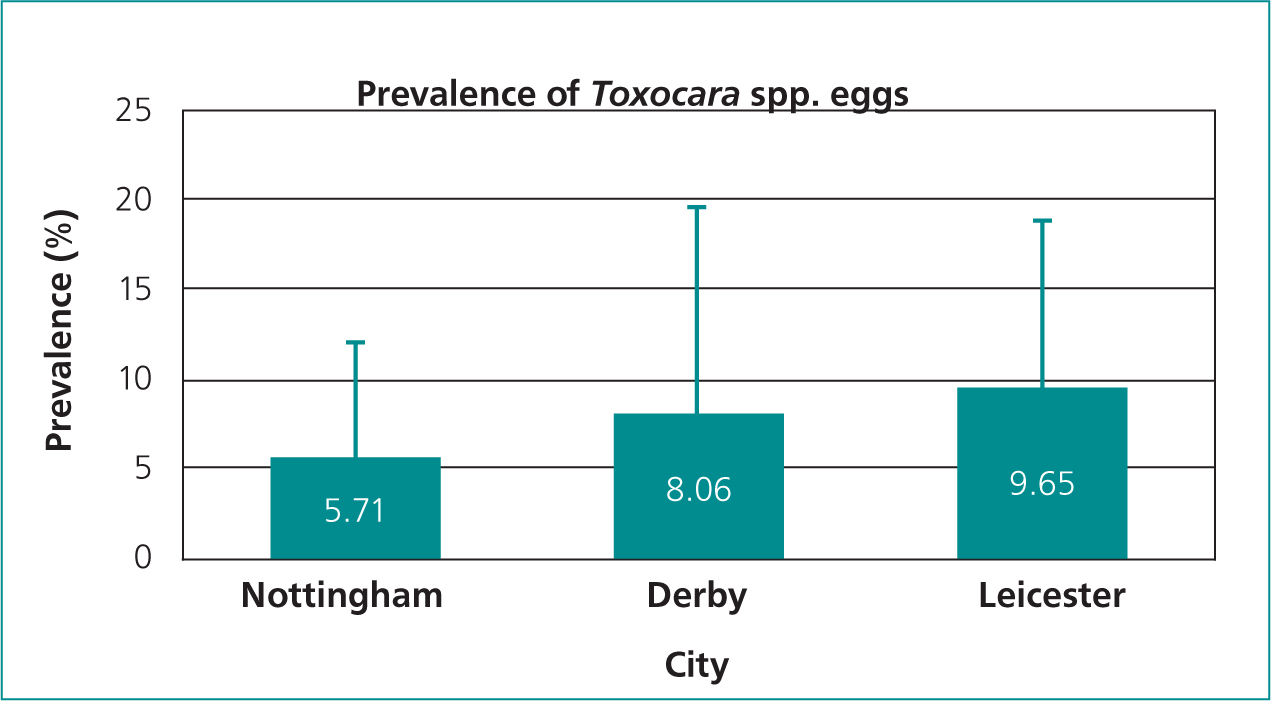
Geo-epidemiological factors
An average prevalence of 8.7% (20/230) was recorded in moist soil samples across the three East Midlands cities (Figure 6), compared with 6.8% (12/175) in dry samples. The difference was not statistically significant (p=0.56). A lower p value of 0.202 was recorded when comparing moist and dry samples from Derby, but the difference was still not significant. The highest moist soil prevalence recording was from Alvaston park (33.3%), while the highest dry soil prevalence (20%) was from Rowley fields and Wescotes park.
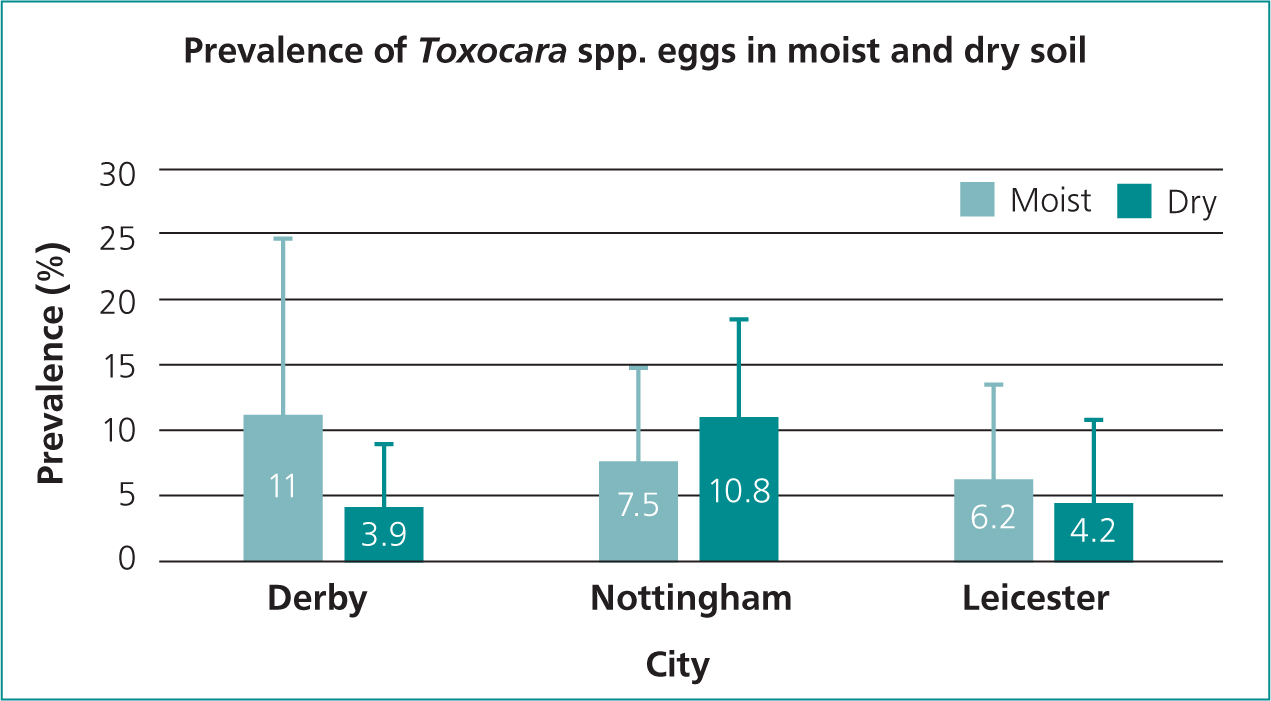
A select number of parks provided samples from both the grounds and play areas (Figure 7). See Table 1 for more details. The city of Nottingham was excluded from this aspect of the study because samples were collected from either parks or play areas. The overall prevalence in the parks was 8.2% (10/121) and inside the play areas was 6.9% (7/101), with non-significant difference (p=0.543).
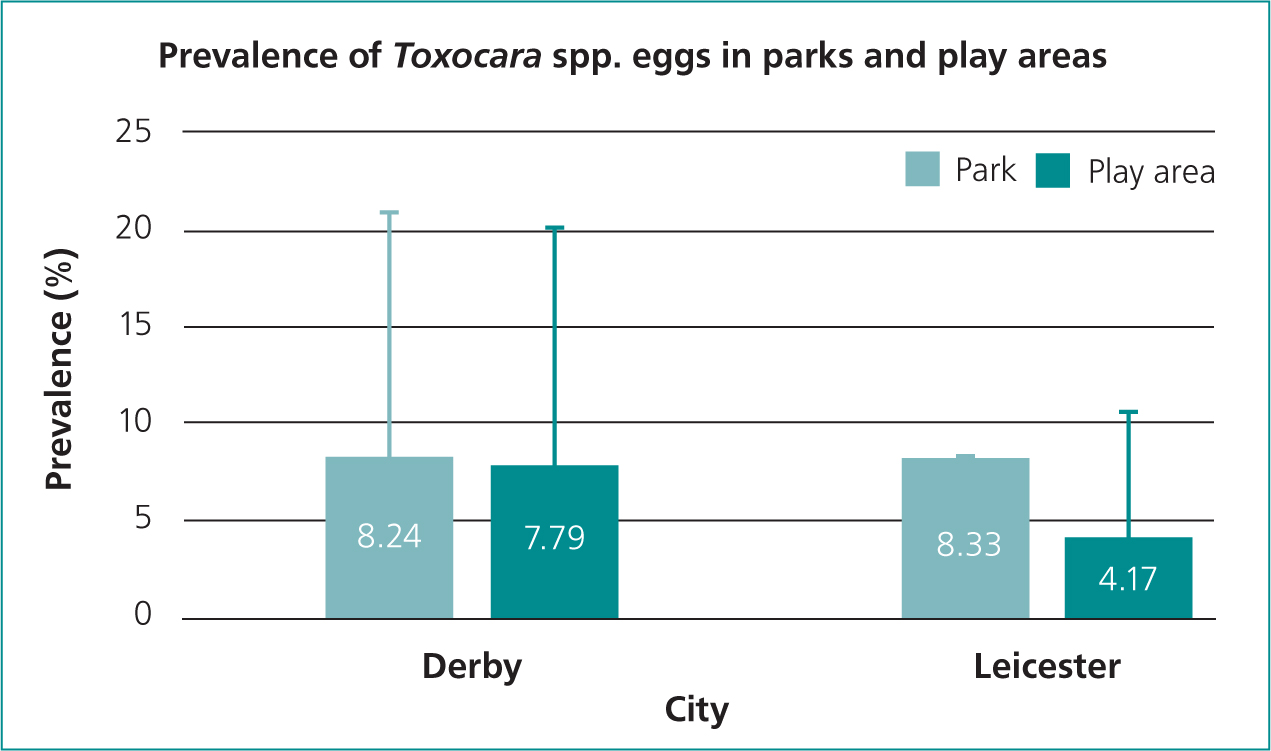
Table 1. Parks and play areas
| Location | City | Play area (Y/N) | Moist/dry | Total number of samples | Number of positive samples | Prevalence (%) |
|---|---|---|---|---|---|---|
| Markeaton Park | Derby | N | M | 12 | 0 | 0 |
| Markeaton Park | Derby | Y | D | 12 | 0 | 0 |
| Alveston Park | Derby | N | M | 12 | 3 | 33.3 |
| Alveston Park | Derby | Y | M | 12 | 3 | 33.3 |
| Bass Recreation Ground | Derby | N | M | 22 | 3 | 15.8 |
| Bass Recreation Ground | Derby | Y | M | 8 | 0 | 0 |
| Chester Green | Derby | N | D | 14 | 0 | 0 |
| Chester Green | Derby | Y | D | 6 | 0 | 0 |
| Parker's Piece | Derby | N | D | 12 | 0 | 0 |
| Parker's Piece | Derby | Y | D | 18 | 2 | 12.5 |
| Arboretum Park | Derby | N | M | 19 | 2 | 11.8 |
| Arboretum Park | Derby | Y | M | 6 | 0 | 0 |
| Osmaston Park | Derby | N | M | 6 | 0 | 0 |
| Osmaston Park | Derby | Y | D | 15 | 1 | 7.1 |
| Braunstone Park | Leicester | N | M | 12 | 1 | 9.1 |
| Braunstone Park | Leicester | Y | M | 12 | 0 | 0 |
| Abbey Park | Leicester | N | D | 12 | 1 | 9.1 |
| Abbey Park | Leicester | Y | D | 12 | 1 | 9.1 |
The prevalence rates in parks and the population density of the surrounding parish ward were compared (Table 2). The authors detected a Spearman's correlation coefficient of 0.286, indicating a weak positive correlation. A similar calculation examining the relationship between prevalence and park size recorded a Pearson's correlation of –0.134, indicating no association.
Table 2. Human population density
| Location | Play area (Y/N) | City | Prevalence | Ward | Population | Size/km2 | Population density/km2 |
|---|---|---|---|---|---|---|---|
| Markeaton Park | N | Derby | 0 | Allestree | 13 233 | 6.476 | 2043 |
| Alveston Park | N | Derby | 33.3 | Alvaston | 16 902 | 7.032 | 2404 |
| Alveston Park | Y | Derby | 33.3 | Alvaston | 16 902 | 7.032 | 2404 |
| Bass Recreation Ground | N | Derby | 15.8 | Arboretum | 22 250 | 3.408 | 6529 |
| Bass Recreation Ground | Y | Derby | 0 | Arboretum | 22 250 | 3.408 | 6529 |
| Chester Green | N | Derby | 0 | Derwent | 13 949 | 5.135 | 2716 |
| Chester Green | Y | Derby | 0 | Derwent | 13 949 | 5.135 | 2,716 |
| Markeaton Park | Y | Derby | 0 | Derwent | 13 233 | 6.476 | 2043 |
| Parker's Piece | N | Derby | 0 | Derwent | 15 570 | 5.135 | 2716 |
| Parker's Piece | Y | Derby | 12.5 | Derwent | 15 570 | 5.135 | 2716 |
| Arboretum Park | N | Derby | 11.8 | Arboretum | 22 250 | 3.408 | 6529 |
| Arboretum Park | Y | Derby | 0 | Arboretum | 22 250 | 3.408 | 6529 |
| Darley Playing Fields | N | Derby | 9.1 | Darley | 15 570 | 5.153 | 3021 |
| Osmaston Park | N | Derby | 0 | Sinfin | 16 171 | 6.871 | 2354 |
| Osmaston Park | Y | Derby | 7.1 | Sinfin | 16 171 | 6.871 | 2354 |
| Braunstone Park | N | Leicester | 9.1 | Braunstone and Rowley fields | 20 069 | 4.76 | 4216 |
| Braunstone Park | Y | Leicester | 0 | Braunstone and Rowley fields | 20 069 | 4.76 | 4216 |
| Fosse Recreation Ground | N | Leicester | 14.3 | Fosse | 14 272 | 1.747 | 8171 |
| Abbey Park | N | Leicester | 9.1 | Abbey | 20 869 | 5.861 | 3559 |
| Abbey Park | Y | Leicester | 9.1 | Abbey | 20 869 | 5.861 | 3559 |
| Rancliffe Gardens | N | Leicester | 0 | Braunstone and Rowley fields | 20 069 | 4.76 | 4216 |
| Prebend Gardens | N | Leicester | 16.7 | Stoneygate | 21 521 | 1.925 | 11 182 |
| Rowley Fields | N | Leicester | 20 | Braunstone and Rowley fields | 20 069 | 4.76 | 4216 |
| Wescotes Park | N | Leicester | 20 | Wescotes | 16 388 | 1.459 | 11 230 |
| Colwick Park | N | Nottingham | 0 | Dales | 17 047 | 5.155 | 3307 |
| St Edwards Park | N | Nottingham | 0 | St Annes | 23 812 | 9392 | |
| The Forest | Y | Nottingham | 5.9 | Bulwell forest | 13 352 | 3.314 | 4029 |
| The Arboretum | N | Nottingham | 9.1 | Hyson green and Arboretum | 26 873 | 2.679 | 10 029 |
| Wollaton Park | N | Nottingham | 0 | Wollaton west | 15 229 | 5.543 | 2748 |
| Sycamore Park | N | Nottingham | 9.1 | Mapperley | 16 544 | 3.612 | 4581 |
| The Meadows Rec Gd | Y | Nottingham | 7.1 | Meadows | 10 654 | 3,381 | 3151 |
| Holme Pierrepoint Park | Y | Nottingham | 20 | Gamston North | 2635 | 7.809 | 337 |
Discussion
The present study found evidence of soil contamination with Toxocara spp. eggs in the East Midlands region. Results indicated that 74% of the parks were contaminated, with soil prevalence levels of 8.06%, 5.71% and 9.65% being recorded in Derby, Nottingham, and Leicester, respectively. These are the prevalence rates for approximately 1 m2 of each park (or play area), meaning that the results are likely to underestimate the actual prevalence considering some of the parks were over 2.023 x 106 m2 in area.
Temperature has a notable role in promoting Toxocara spp. egg development and reducing the number of malformed eggs (Gamboa, 2005). However, the temperatures in each city were almost identical from April to May 2018 (Anon, 2018b), reflecting their proximity in addition to the urban heat island effect whereby cities are warmer than neighbouring rural areas (Tong et al, 2021). T. canis egg prevalence across parks in Niš, Serbia was found to be 17.5%. Niš had an average annual temperature of 12.08°C (Ristić et al, 2020), above the 10°C in the East Midlands (Anon, 2018a). There was a park prevalence rate of 94% in Greece, with an overall sample prevalence of 17.2% (Papavasilopoulos et al, 2018). In Athens, Greece the average March temperature was 15°C (Anon, 2018c), considerably warmer than 4°C in the East Midlands (Anon, 2018b). Higher temperatures promote Toxocara spp. egg embryonation, therefore in both studies the warmer climates may have reduced the time taken for eggs to become infective, which has been previously established (Okoshi and Usui, 1968), potentially allowing an increased spread of the roundworm eggs within the environment.
Prevalence rates can still differ in regions with similar climatic conditions. A study conducted in Hannover, Germany found an overall sandpit prevalence of 23.2%. This exceeds the 6.93% recorded in the UK (although some of the samples were not from sandpits). Nonetheless, Hannover and the East Midlands have a very similar climate (Anon, 2016b). The study in Germany proposed that the cool wet winters seen in Central Europe aided the survival of Toxocara spp. eggs, although the average winter temperature and precipitation levels are lower in Hannover (Anon, 2016b). Perhaps other factors, such as environmental control in the UK (£100 fines for dog fouling) may have contributed to lower prevalence rates in the present study (Anon, 2022).
A study conducted in Lisbon, Portugal found that 34.4% of all parks and 85.5% of all sandpits were contaminated. The park contamination rate was considerably lower than that of the East Midlands (74%), although Lisbon had been experiencing a hot, arid year which does not promote the survival of Toxocara spp. eggs (Otero et al, 2018). All Toxocara spp. eggs found in the soil/sand samples came from cats, hence the elevated levels in sandpits may reflect cats' preference for the substrate. Such an assumption was also made in the present study when comparing play areas to parks.
Levels recorded in play areas (6.93%) were well below those observed in the rest of the respective parks (8.26%). The play areas of Alvaston Park and Holme Pierrepoint park were identified as anomalies, with a prevalence of 33.3% and 20%, respectively. A two-tail p value of 0.543 also suggests that the findings are not significant. Nonetheless, even lower levels would be expected in playgrounds, given the surrounding fences and signs prohibiting dogs. A plausible explanation is that cats and foxes are responsible for contaminating play areas. A study conducted in the Czech Republic recorded its highest prevalence (45%) in backyards inhabited by feral cats. It also found no marked difference between sand pits with and without dog exclusion, with a Toxocara spp. egg prevalence of 11.9%. Furthermore, the study suggested that cats prefer the sand substrate, burying their stools in sandpits (Dubná et al, 2007a). This is consistent with a Toxocara spp. contamination study which observed defecation habits, finding cats to be the main cause of faecal contamination in sandpits, with faecal deposits evenly distributed (Uga et al, 1996). Another study conducted in Poland found that 85.4% of all Toxocara spp. egg in cities were T. cati (Mizgajska-Wiktor et al, 2017). Therefore, although a lack of differentiation between Toxocara spp. in the present study means it can only be theorised, cats may be posing more of a contamination risk to play areas in the East Midlands than dogs. The role of foxes in transmission should also be considered.
While there is limited literature regarding fox transmission, studies have shown them to be carriers of T. canis. A 1993 study in Bristol, England found a prevalence of 58.2% in foxes. A higher prevalence was found in cubs suggesting that in-utero transmission may be occurring (Richards et al, 1993). The same suggestion was drawn from a study in Geneva which found the highest prevalence rates in juvenile foxes in spring, before levels dropped to the rates seen in adults (Reperant et al, 2007). In 1995 a similar study conducted in the UK also found a similar prevalence in urban and rural foxes (Richards et al, 1995). It is therefore conceivable that if both rural and urban foxes carry the parasite, they could be contaminating parks. It is worth mentioning that while foxes can have a high prevalence of T. canis infection, modelling found that the numbers of dogs and cats and their volume of faecal output dwarves that of foxes, making their contribution to overall contamination very small (Morgan et al, 2013).
The number of unowned cats (e.g. feral, lost or abandoned) in urban areas in the UK is approximately a quarter of a million and urban areas with higher human population density and socioeconomic deprivation may have more unowned cats (McDonald and Skillings, 2021). With an average of 9.3 unowned cats per km2 in the UK, the role of cats in contaminating the soil of public places in East Midlands should not be underestimated. Population density in the surrounding Parish ward and soil prevalence were analysed, however only a weak positive correlation was found (Spearman's value of 0.286). Such findings would mitigate the role population density plays in Toxocara spp. prevalence, however, certain socioeconomic aspects were not assessed. These include the distribution of pet owners within each city, the wealth of different regions, access to veterinary care and back-gardens in which their dogs could defecate.
While population density may not be a crucial factor, inspecting the number of green spaces in a city region could be more significant. A study in Prague found the highest levels of soil contamination in residential areas with small patches of greenery (Dubná et al, 2007b). Furthermore, 7/10 visits to urban greenspaces in the UK occur via foot and urban greenspaces are being increasingly utilised (England, 2018). This suggests that when nearby greenspaces are limited, or when parks are particularly popular and within walking distance for many people, they may be heavily contaminated. Holme Pierrepont Park, home to the national water sports centre, recorded a high prevalence rate (20%). Similarly, Alvaston park, which possessed the highest prevalence (33.3%), is situated just 2 miles from Derby city centre and regularly holds events such as weekly 5 km runs. In contrast, the most visited park in the East Midlands (City Council, 2019), Markeaton park, which is situated 2 miles from Derby city centre, recorded no positive samples. This may be an anomaly or reflect the impact of other factors such as funding for park maintenance.
A study conducted in the Philippines identified soil texture as a factor influencing prevalence of Toxocara spp. eggs, with a significantly lower prevalence (18%) recorded in clay soil compared with over 30% in silty, sandy, and loamy soil (Paller and de Chavez, 2014). A similar study conducted in Malaysia found a prevalence of 85.71% in sandy soil and 0% in clay soil (Haziqah et al, 2021). It is suggested that this is because of animals' ability to dig and bury faeces in softer soil, therefore creating a preference towards softer textures (Paller and de Chavez, 2014). The present study did not examine the effect of soil texture on the prevalence of Toxocara spp. eggs. However, moisture was deemed to be a potential factor that can influence prevalence of Toxocara spp. eggs. A 25% increase in prevalence was seen when comparing moist to dry soil samples: 8.7% vs 6.68%. These findings are in agreement with a study conducted in Dublin which found that moist samples had a prevalence of 17.89% compared with 12.82% in dry samples (O'Lorcain, 1994). In contrast, a study in Madrid, Spain found only 16.4% of parks were contaminated with Toxocara spp. eggs, well below the 74% recorded in the present study. However, the paper concluded that the low contamination levels could be attributed to the low soil moisture (Dado et al, 2012). The present study's findings correspond to experimental studies that found moisture to be essential for egg maturation and survival (Gamboa, 2005), because of the role of moisture in preventing desiccation and maintaining the viability of eggs (Keegan and Holland, 2013). Therefore, it would appear that more eggs can survive and accumulate in a moist environment. This is a concern given that the level of precipitation in the East Midlands region averages 43.08 mm per month (Anon, 2016a), although standardised methods of quantifying moisture are needed before its true impact can be established.
Study limitations
The study used established methods to provide original data on a subject of considerable relevance to both animal and human health, thus contributing to the ‘eco-health’ and ‘one health’ approaches for understanding the epidemiology of and dealing with Toxocara spp. infection. Some limitations should be highlighted. First, the results recorded across the East Midlands had high variations. Derby had the highest standard deviation of 11.43, highlighting the heterogeneity detected across the region and the insufficient control implemented in the methodology. Moisture level was a subjective estimate as only one person graded the samples in this study. Certain variables were also not controlled, such as not collecting moist and dry samples from each park. Moreover, not collecting samples from parks and their respective play areas in Nottingham meant calculations could not accurately portray the entire region. The control outlined in the methodology ‘number of samples taken will depend on the size of the park and play area’ was not followed; 12 samples were collected from both Wollaton deer park (500 acres) and Markeaton park (207 acres). By not accurately reflecting park size like other studies did (Papavasilopoulos et al, 2018), there was not an equal opportunity for Toxocara spp. egg detection. These limitations may have reduced the reliability of the results and correlation between prevalence and certain geo-epidemiological factors. Despite the evidence that T. cati eggs are involved in contaminating the soil in different cities around the world, the role of T. cati could not be ascertained in the current study because of the lack of molecular analysis.
Conclusions and future directions
This study revealed that soil in the East Midlands region is contaminated with Toxocara spp. eggs. The methodology of this study has facilitated these findings although the results could be developed through both quantitative analysis of moisture and exploration of different socioeconomic factors which were beyond the scope of this study. Additionally, research into the potential role of foxes in transmission would expand on the theories proposed by this study. Comparisons between the present study and other studies in Europe revealed that certain climatic conditions in the UK are favourable for Toxocara spp. which, coupled with the growing pet population, indicate that more effort is needed to control environmental contamination. Furthermore, this study has identified a risk to children playing in parks because of potential Toxocara spp. egg exposure. Differentiation between Toxocara spp. eggs would allow verification of whether cats are responsible for play area contamination. Improved environmental control is possible, but poses challenges because of the robustness of Toxocara spp. eggs (Mizgajska, 2001). Vertical transmission could therefore be targeted, with a recent paper proposing that developing a programme to deal with vertical transmission whereby a bitch is de-wormed during pregnancy would be ideal (Schwartz et al, 2022). Cats should also be considered when devising new control measures, especially when long-term studies believe the impetus should be shifted from dogs to cats (Mizgajska-Wiktor et al, 2017).
KEY POINTS
- Toxocara canis and Toxocara cati are zoonotic intestinal roundworms of dogs and cats respectively. Human infection from both parasites can lead to clinical toxocariasis.
- Human toxocariasis may present in several ways including visceral, ocular, neurological and covert forms.
- Transmission occurs primarily from the ingestion of embryonated Toxocara spp. eggs; both T. canis and T. cati.
- Embryonated eggs may be ingested from soil (geophagia) and the extent to which soil is contaminated with Toxocara eggs in shared public spaces is important to help assess the risk of human exposure.
- This study demonstrated significant soil contamination with Toxocara eggs in East Midland parks (74%).
- The overall prevalence of Toxocara eggs in the soil of East Midland parks was 7.9% (5.71% in Nottingham, 8.06% in Derby, 9.65% in Leicester).
- A range of measures continue to be required to reduce soil contamination, including routine deworming of cats and dogs, anti-dog fouling campaigns, humane control of stray/feral cat populations and raising public awareness.


